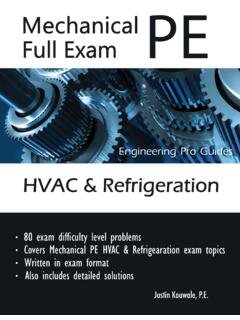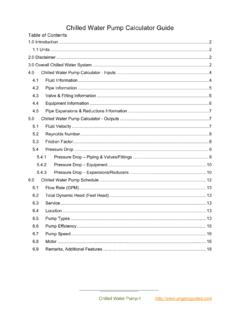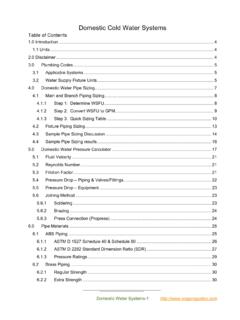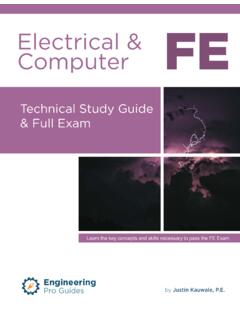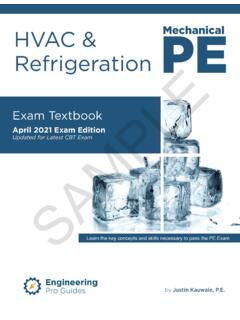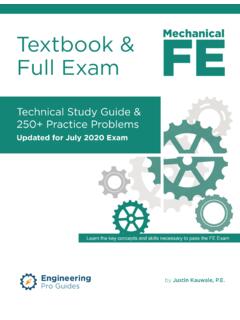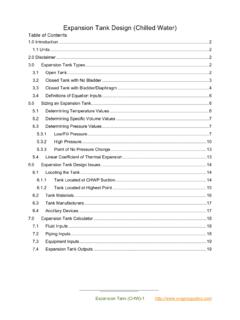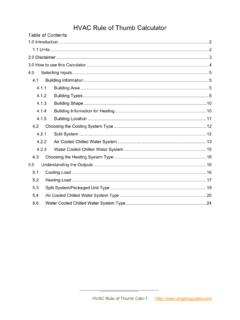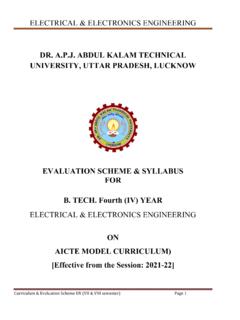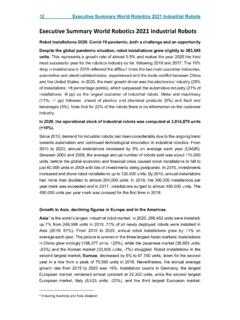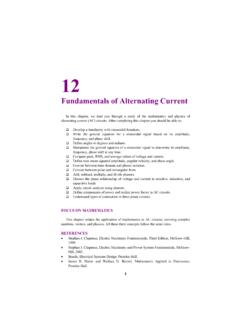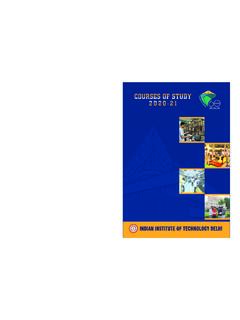Transcription of PowerPowerPE - Engineering Pro Guides
1 Justin Kauwale, exam difficulty level problems and detailed solutionsPEFollows the exam outline and covers the main concepts not tested by other sample , Electromagnetic Devices, Codes, PECs, PerformancePowerPowerTransmission, Rotating Machines, Protection, Special ExamFull Exam SECTION 1 INTRODUCTION Introduction-1 Introduction Table of Contents Introduction .. 2 Key Concepts and Skills .. 2 Units .. 5 Disclaimer .. 5 How to use this Book .. 5 Recommended References .. 9 NFPA 70, NEC Handbook, 2014 Edition .. 9 Engineering Unit Conversions Book .. 9 Schaum's Outline of Basic Electricity .. 10 Schaum's Outline of electrical Power Systems .. 10 Electric Machinery Fundamentals .. 10 Power System Analysis .. 10 Online Articles .. 10 IEEE Color Books .. 11 Introduction-2 INTRODUCTION One of the most important steps in an engineer's career is obtaining the professional Engineering ( ) license.
2 It allows an individual to legally practice Engineering in the state of licensure. This credential can also help to obtain higher compensation and develop a credible reputation. In order to obtain a license, the engineer must first meet the qualifications as required by the state of licensure, including minimum experience, references and the passing of the National Council of Examiners for Engineering and Surveying (NCEES) exam. Engineering Pro Guides focuses on helping engineers pass the NCEES exam through the use of free content on the website, and through the creation of books like sample exams and Guides that outline how to pass the PE exam. The key to passing the PE exam is to learn the key concepts and skills that are tested on the exam. There are several issues that make this key very difficult. First, the key concepts and skills are unknown to most engineers studying for the exam.
3 Second, the key concepts and skills are not contained in a single document. This technical guide teaches you the key concepts and skills required to pass the electrical - Power Exam. KEY CONCEPTS AND SKILLS How are the key concepts and skills determined? The key concepts and skills tested in this sample exam were first developed through an analysis of the topics and information presented by NCEES. NCEES indicates on their website that the Exam will cover an AM exam (4 hours) followed by a PM exam (4 hours) and that the exam will be 80 questions long, 40 questions in the morning and 40 questions in the afternoon. The Power electrical PE exam will focus on the following topics as indicated by NCEES. ( ): I. General Power Engineering (24 questions) A) Measurement and Instrumentation (6 questions) 1 Instrument transformers 2 Wattmeters 3 VOM metering 4 Insulation testing 5 Ground resistance testing B) Special Applications (8 questions) 1 Lightning and surge protection 2 Reliability 3 Illumination Engineering 4 Demand and energy management calculations 5 Engineering economics C) Codes and Standards (10 questions) 1 National electrical Code (NEC) 2 National electrical Safety Code (NESC) Introduction-11 2.
4 Grounding and Bonding electrical Systems: this book shows the basic grounding designs and also covers the grounding testing, which is needed for the Measurement and Instrumentation section. 3. An Introduction to Symmetrical Components, System Modeling and Fault Calculation: this books covers the symmetrical components and every type of fault you need for the PE exam. IEEE COLOR BOOKS By IEEE The IEEE Color Books contain a lot of information that is used in nearly all of the recommended references. There are 13 volumes and each book is given a color as shown in the list below. For the purposes of the exam you should only get the items in bold. Red Book IEEE STD 141 -1993 (R1999), Recommended Practice for the Electric Power Distribution for Industrial Plants Green Book IEEE STD 142 -2007, Recommended Practice for Grounding of Industrial and Commercial Power Systems This book will help you to understand the purpose of grounding and the different approaches to grounding.
5 There is also information on lightning protection in this book. Gray Book IEEE STD 241 -1990 (R1997), Recommended Practice for electrical Power Systems in Commercial Buildings Buff Book IEEE STD 242 -2001, Recommended Practice for Protection and Coordination of Industrial and Commercial Power Systems This book will help you to understand short circuit calculations, time current coordination graphs and different approaches to the protection of various types of equipment like motors, generators, transformers, buses and conductors. Brown Book IEEE STD 399 -1997, Recommended Practice for Industrial and Commercial Power Systems Analysis Introduction-12 This book provides background on the various power system analysis studies. This analysis includes power flow and harmonics. If you need more background information on these items, then this book should be of help.
6 Orange Book IEEE STD 446 -1995 (R2000), Recommended Practice for Emergency and Standby Power Systems for Industrial and Commercial Applications Gold Book IEEE STD 493 -2007, Recommended Practice for the Design of Reliable Industrial and Commercial Power Systems White Book IEEE STD 602 -2007, Recommended Practice for electrical Systems in Health Care Facilities Bronze Book IEEE STD 739 -1995 (R2000), Recommended Practice for Energy Management in Industrial and Commercial Facilities Yellow Book IEEE STD 902 -1998, Guide for Maintenance, Operation, and Safety of Industrial and Commercial Power Systems Blue Book IEEE STD 1015 -2006, Recommended Practice for Applying Low-Voltage Circuit Breakers Used in Industrial and Commercial Power Systems Emerald Book IEEE STD 1100 -2005, Recommended Practice for Powering and Grounding Electronic Equipment Violet Book IEEE STD 551 -2006, Recommended Practice for Short-Circuit Calculations in Industrial and Commercial Power Systems i Justin Kauwale is a participant in the Amazon Services LLC Associates Program.
7 An affiliate advertising program designed to provide a means for sites to earn advertising fees by advertising and linking to ii Justin Kauwale is a participant in the Amazon Services LLC Associates Program, an affiliate advertising program designed to provide a means for sites to earn advertising fees by advertising and linking to SECTION 2 AM SESSION QUESTIONS QUESTION 1 CIRCUIT ANALYSIS A three phase, 500 kVA load is served by a 0 kV line. The load has a power factor of leading. What is the line to neutral impedance of the load? (A) + (B) (C) (D) + QUESTION 2 CIRCUIT ANALYSIS A three-phase, wye connected, balanced load consumes 100 kW and is rated at 480 V (line voltage). If one of the load s phases is removed ( =0), what is the new power consumption? Assume a power factor of (A) 50 kW (B) 66 kW (C) 75 kW (D) 100 kW Power PE Full Exam AM Session Questions -1 QUESTION 14 DEVICES AND POWER ELECTRONIC CIRCUITS A single phase, 120V (RMS) AC power supply provides power to a load with an impedance of 10 + j0 ohms.
8 A 120V battery is also in series with this load. What is the max voltage at the resistor? (A) 120V (B) 208V (C) 240V (D) 290V QUESTION 15 DEVICES AND POWER ELECTRONIC CIRCUITS The load in the circuit below experiences an effective voltage of 200 V. If diode A fails open, then what will be the effective voltage seen by the load? Assume the load is purely resistive with a load of R. (A) 100 V (B) 120 V (C) 141 V (D) 200 V Power PE Full Exam AM Session Questions -8 QUESTION 38 TRANSMISSION AND DISTRIBUTION A line to line fault occurs between phases A and B of a three phase generator. What is the sum of the short circuit currents through all three phases (A, B and C)? Assume there is no neutral and the positive, negative and zero sequence impedances are all equal to pu. (A) 0 pu (B) 50 pu (C) 87 pu (D) 100 pu QUESTION 39 TRANSMISSION AND DISTRIBUTION Which of the following is most likely not a primary purpose of bonding or electrically connecting two objects together?
9 (A) Minimize the voltage difference between the two objects. (B) Provide a connection to earth (ground). (C) Prevent sparking between two objects. (D) Allow high currents to pass through the objects with minimal arcing. Power PE Full Exam AM Session Questions -20 SECTION 3 PM SESSION QUESTIONS Power PE Full Exam PM Session Questions -6 QUESTION 51 - PROTECTION If circuit breaker 1 fails during a short circuit condition of 1,000 amps, then what is the maximum time that the fault be resolved? (A) Instantaneous (B) 10 seconds (C) 18 seconds (D) The fault will not be cleared until the equipment becomes damaged. QUESTION 68 SPECIAL APPLICATIONS Which of the following locations is most appropriate location for a surge protection device? (A) In series at the point of use of a critical load. (B) In parallel with the power supply service entrance to a computer server facility.
10 (C) On a conductor prior to a VFD, in order to limit harmonics. (D) On a conductor that serves equipment with low power factors. QUESTION 69 SPECIAL APPLICATIONS The following is the electricity bill for a customer for a day. Calculate the total bill based on the following costs. Cost per kWH = $ Demand charge = $ per max kW. KW kWH KW kWH KW kWH Hour 1 2 2 Hour 9 25 25 Hour 17 5 5 Hour 2 2 2 Hour 10 25 25 Hour 18 5 5 Hour 3 2 2 Hour 11 70 70 Hour 19 5 5 Hour 4 2 2 Hour 12 25 25 Hour 20 5 5 Hour 5 2 2 Hour 13 25 25 Hour 21 5 5 Hour 6 2 2 Hour 14 25 25 Hour 22 5 5 Hour 7 2 2 Hour 15 25 25 Hour 23 5 5 Hour 8 2 2 Hour 16 25 25 Hour 24 5 5 (A) $ (B) $ (C) $ (D) $ Power PE Full Exam PM Session Questions -16 QUESTION 80 CODES AND STANDARDS A single phase, 250 kcmil, branch uncoated copper THWN conductors in steel conduit, serves a load located 1,000 from the panel.
